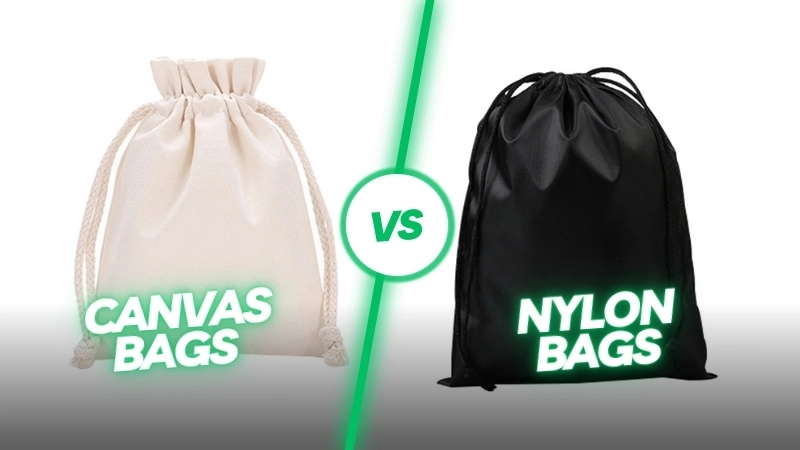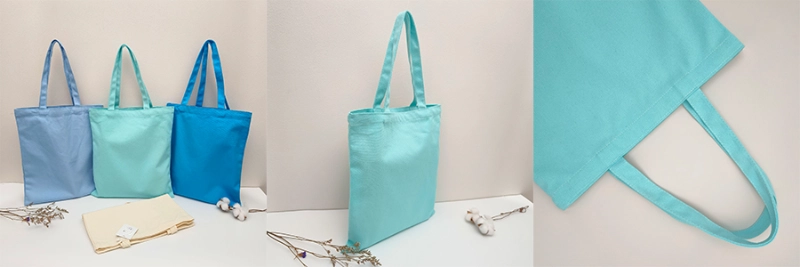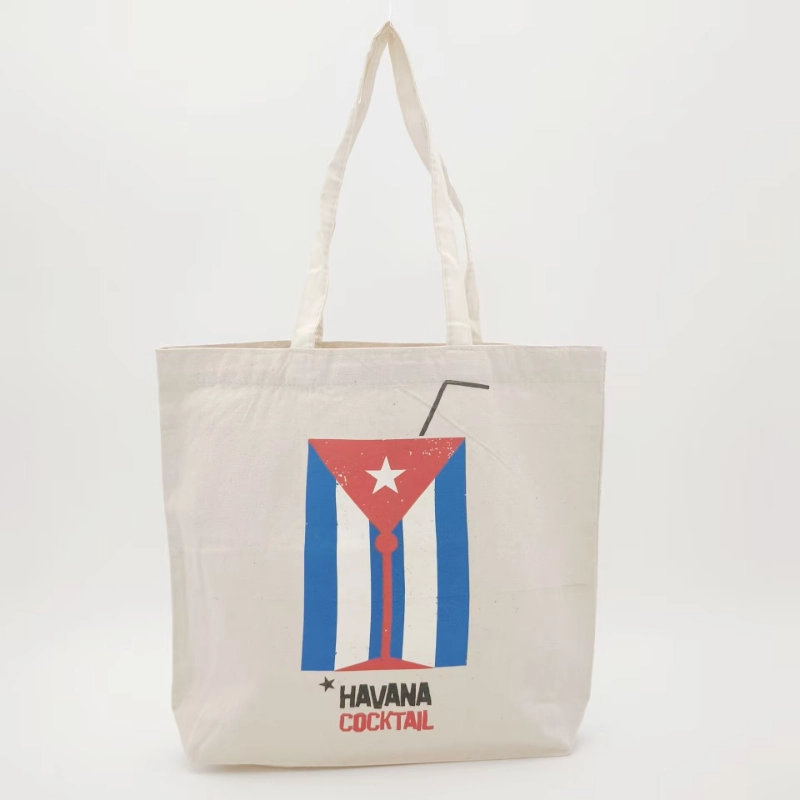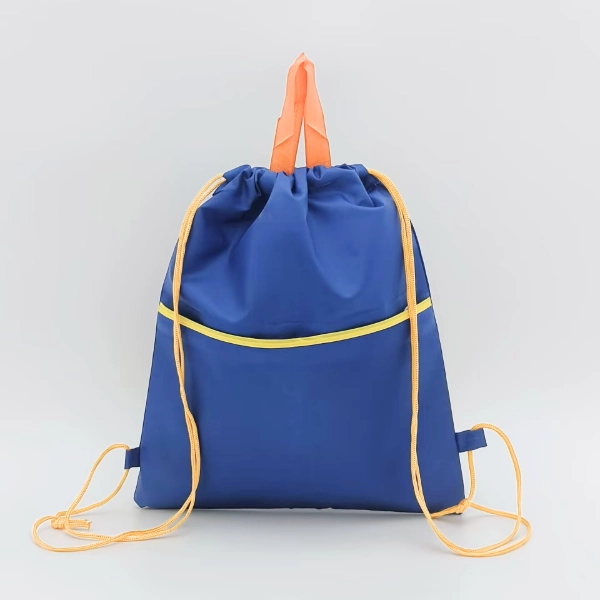
Canvas bags and nylon bags play important roles in modern life. They not only change the way we carry things, but also offer a variety of options in terms of environmental friendliness, fashion, and functionality.
What are the differences bewteen canvas bags and nylon bags? Canvas bags are made from cotton or linen fibers, sometimes blended with polyester, making them highly durable and strong enough to carry heavy items. They are also more eco-friendly. Canvas bags have a simple appearance, with good print quality, making them ideal for minimalist and environmentally-friendly designs. However, the print quality on canvas bags is not as fine as on nylon bags. Although canvas bags are less waterproof, their water resistance can be enhanced with coatings. The texture of canvas is soft, and it’s relatively comfortable to carry, especially for long periods. Overall, canvas bags tend to be slightly more expensive than nylon ones.
Nylon bags are made from nylon fibers, known for their high strength, durability, lightness, and waterproof features, making them ideal for outdoor and damp environments. Nylon bags have a smooth appearance, with bright and detailed prints. Their water resistance is much stronger, making them suitable for prolonged exposure to moisture. Nylon bags are lighter but less comfortable when carrying heavy items, so they are better suited for short-term or lightweight use. Nylon bags are generally more affordable than canvas bags.
Although the main differences between canvas and nylon bags have been outlined, understanding their chemical composition, durability, waterproof properties, appearance, and print quality can help you more fully evaluate their suitability. Delving into the key characteristics of these two types of bags will help you find the best option for your needs.



Canvas bags and nylon bags each have their unique advantages and suitable applications. Canvas bags, with their eco-friendliness, durability, and natural texture, are perfect for everyday use and environmental promotion, especially for carrying heavy items or designs that seek a natural aesthetic. Although they have limited water resistance, a coating treatment can enhance their functionality. On the other hand, nylon bags are ideal for outdoor activities and high-end custom needs, thanks to their high strength, lightness, and excellent waterproof properties. Nylon bags also offer more detailed printing, making them perfect for intricate patterns and vibrant colors.
When choosing, it’s important to consider your specific needs: if you need an eco-friendly, durable, and everyday-use bag, a canvas bag is the ideal choice; if you seek a lightweight, waterproof, and high-strength bag, then a nylon bag is more suitable. Understanding the pros and cons of both materials will help you make a smarter decision in various situations.
Yanxin Bag offer a wide range of canvas and nylon bags, perfect for shopping, promotions, brand marketing, and environmental campaigns. With our custom services, you can choose the material, color, size, and printing options to create a bag that perfectly fits your brand image.
Contact Yanxin Bag now for free design consultation and samples—customize your personalized bag and leave a lasting impression!
Want a complete overview of how canvas tote bags are made and used?
This guide combines design principles, production steps, and usage scenarios, explaining material selection, printing techniques, sizing, customization, and care. It also discusses handle structure, inner lining, and sustainable applications, offering a full reference for anyone sourcing or designing canvas totes.
Unsure how cotton and canvas differ in performance and appearance?
This article compares the two fabrics in texture, weave, durability, and printability, clarifying how each behaves in branding, sustainability, and maintenance. It provides insight into choosing the right option according to your product positioning and practical needs.
Want your canvas tote to stay in shape after washing?
This article provides a full cleaning and care process—from preparation and washing to drying and maintenance—while detailing fabric-specific methods for cotton and blended canvas. It also explains how to protect prints and prevent shrinkage or fading, ensuring your bag remains durable and fresh.
Looking for the best printing technique for your canvas designs?
This guide explains the main printing and embellishment methods for canvas bags—covering screen printing, heat transfer, UV printing, embroidery, and more. It outlines how each works with different fabrics and finishes, helping you select the most effective process for your logo, artwork, and brand goals.
Wondering how canvas and leather bags differ for branding use?
This article contrasts the two materials in texture, maintenance, sustainability, and aesthetic tone. It discusses how canvas supports flexible customization and eco values, while leather emphasizes luxury and durability—guiding brands to balance cost, audience, and long-term positioning.
Get a free quote and expert consultation today. Let's bring your brand vision to life.
Answer: Durability, breathability, water resistance with treatment, printability, lightweight and portability, washability and reusability, customizability, versatility, environmental friendliness, and cost-effectiveness are some of the key properties of canvas bags.
Answer: Canvas bags are environmentally friendly because they are reusable, made from natural, biodegradable materials like cotton or linen, and help reduce plastic waste. They promote sustainable habits and have a lower environmental impact compared to single-use plastic bags.
Answer: To clean a canvas bag, gently hand wash it in cold water with mild detergent. Avoid scrubbing too hard, especially around the printed areas, to prevent damage. After washing, allow the bag to air dry naturally. Keep in mind that canvas may shrink slightly after washing, so avoid using hot water or dryers.
Answer: Canvas bags are not naturally waterproof, but they can be treated with a waterproof coating or finish to make them water-resistant. While untreated canvas can absorb moisture, treated canvas bags can repel water and are more suitable for use in wet conditions.
Answer: To prevent fading, always use high-quality fabric paints or dyes, and let your design dry completely before use. For embroidery or iron-on transfers, heat-set your design according to the product instructions to ensure durability.
Answer: Yes, bleach art is an exciting way to create unique designs on a canvas bag. Use a diluted bleach solution and apply it with a spray bottle or brush. Just remember to wear gloves and test on a small area first.
Answer: Both are durable, but canvas bags excel in carrying heavy loads due to their thick, woven structure, while nylon bags are better suited for outdoor use thanks to their abrasion and water resistance.
Answer: Nylon bags allow for sharper, more detailed prints due to their smooth surface, while canvas bags provide a softer, natural texture that suits minimalist or eco designs.
Answer: Applying a waterproof coating or wax layer to a canvas bag can significantly enhance its resistance to moisture and light rain.
Answer: Nylon bags are less eco-friendly due to their synthetic origin, but using recycled nylon can reduce environmental impact and promote sustainability.

Order or no-order we are Always here to help you!
We will contact you within 1 working day, please pay attention to the email with the suffix “@yanxinbag.com”.
Order or no-order we are Always here to help you!
We will contact you within 1 working day, please pay attention to the email with the suffix “@yanxinbag.com”.